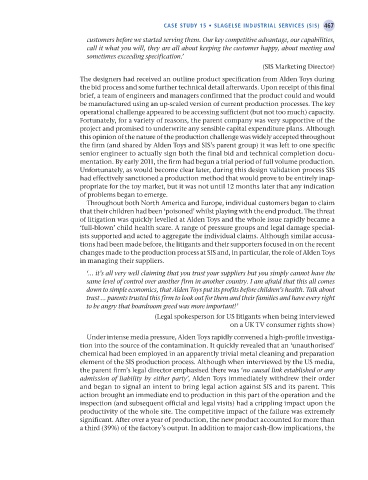Page 492 - Operations Strategy
P. 492
case study 15 • slagelse IndustrIal servIces (sIs) 467
customers before we started serving them. Our key competitive advantage, our capabilities,
call it what you will, they are all about keeping the customer happy, about meeting and
sometimes exceeding specification.’
(SIS Marketing Director)
The designers had received an outline product specification from Alden Toys during
the bid process and some further technical detail afterwards. Upon receipt of this final
brief, a team of engineers and managers confirmed that the product could and would
be manufactured using an up-scaled version of current production processes. The key
operational challenge appeared to be accessing sufficient (but not too much) capacity.
Fortunately, for a variety of reasons, the parent company was very supportive of the
project and promised to underwrite any sensible capital expenditure plans. Although
this opinion of the nature of the production challenge was widely accepted throughout
the firm (and shared by Alden Toys and SIS’s parent group) it was left to one specific
senior engineer to actually sign both the final bid and technical completion docu-
mentation. By early 2011, the firm had begun a trial period of full volume production.
Unfortunately, as would become clear later, during this design validation process SIS
had effectively sanctioned a production method that would prove to be entirely inap-
propriate for the toy market, but it was not until 12 months later that any indication
of problems began to emerge.
Throughout both North America and Europe, individual customers began to claim
that their children had been ‘poisoned’ whilst playing with the end product. The threat
of litigation was quickly levelled at Alden Toys and the whole issue rapidly became a
‘full-blown’ child health scare. A range of pressure groups and legal damage special-
ists supported and acted to aggregate the individual claims. Although similar accusa-
tions had been made before, the litigants and their supporters focused in on the recent
changes made to the production process at SIS and, in particular, the role of Alden Toys
in managing their suppliers.
‘… it’s all very well claiming that you trust your suppliers but you simply cannot have the
same level of control over another firm in another country. I am afraid that this all comes
down to simple economics, that Alden Toys put its profits before children’s health. Talk about
trust … parents trusted this firm to look out for them and their families and have every right
to be angry that boardroom greed was more important!’
(Legal spokesperson for US litigants when being interviewed
on a UK TV consumer rights show)
Under intense media pressure, Alden Toys rapidly convened a high-profile investiga-
tion into the source of the contamination. It quickly revealed that an ‘unauthorised’
chemical had been employed in an apparently trivial metal cleaning and preparation
element of the SIS production process. Although when interviewed by the US media,
the parent firm’s legal director emphasised there was ‘no causal link established or any
admission of liability by either party’, Alden Toys immediately withdrew their order
and began to signal an intent to bring legal action against SIS and its parent. This
action brought an immediate end to production in this part of the operation and the
inspection (and subsequent official and legal visits) had a crippling impact upon the
productivity of the whole site. The competitive impact of the failure was extremely
significant. After over a year of production, the new product accounted for more than
a third (39%) of the factory’s output. In addition to major cash-flow implications, the
Z15 Operations Strategy 62492.indd 467 02/03/2017 13:59

